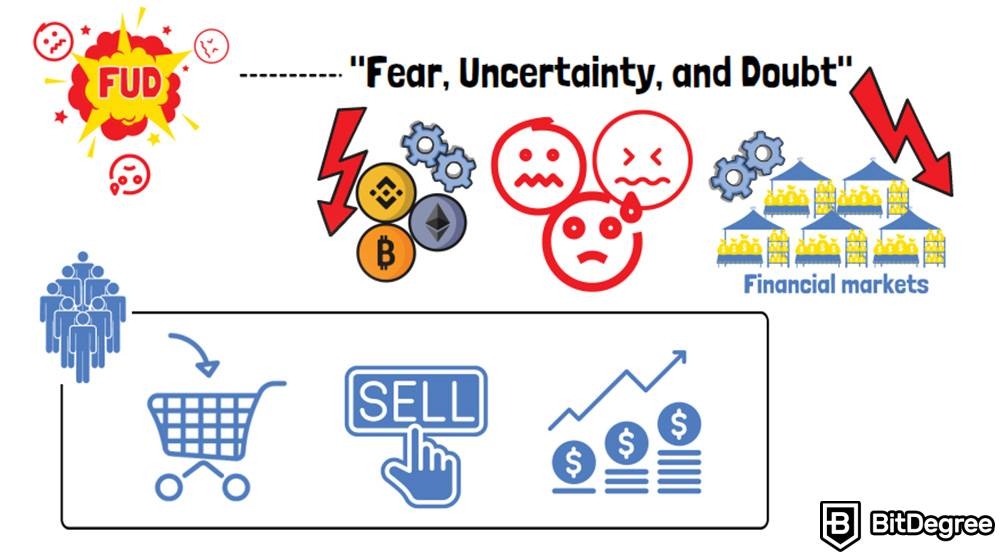7.8 What is FUD: How to Use It to Your Advantage While Investing in Crypto?
Free Airdrop Season 7 is LIVE! Answer fun questions or do simple tasks to earn rewards from the $30K BitDegree prize pool. Participate Now ! 🔥
In this section, we’re going to talk about what is FUD in investing, and how to profit from it!
Ironically, the word “FUD” causes FUD for those who don’t know what this abbreviation stands for, which is “Fear, Uncertainty and Doubt”. But, there’s no need to fear FUD. You can even profit from it, and there are many who do exactly that.
Emotions play a critical role in everything. Therefore, it’s not a surprise that markets, especially ones that are as versatile as crypto, are directly affected by the predominant sentiments. But, once you become aware of how it influences people’s financial decisions, you learn how to read between the lines, and how to avoid being blinded by irrational fear.
In this section, I’m going to talk about what is FUD in crypto investing - specifically, how it affects people’s investment strategies and the cryptocurrency market, and how not to give into it. I’ll share particular examples about how FUD had led people into financial losses, and the exact opposite - how smart investors sensed the market sentiment, and ended up counting financial gains while everyone else thought that the ship was sinking.
Fear no more, and let’s dive into it!

Video Explainer
Video Explainer: What is FUD: How to Use It to Your Advantage While Investing in Crypto?
Reading is not your thing? Watch the "What is FUD: How to Use It to Your Advantage While Investing in Crypto?" video explainer
What is FUD in Crypto? (Fear, Uncertainty & Doubt Explained)


What is FUD?
As I’ve told you in the introductory part, FUD stands for Fear, Uncertainty, and Doubt. These three unpleasant emotions play a huge part in crypto, as well as the broader financial markets, in general. They affect how people act, what they buy, what they sell, where and how much they invest. When these emotions prevail, it affects the entire industry, and numbers on charts turn red.

These sentiments arise and grip the market for various reasons, and on different occasions. Sometimes, FUD spreads uncontrollably for objective reasons, such as huge companies going bankrupt, or political bodies implementing policies that may potentially be detrimental to particular investments.
A great example of this could be found in the year 2021. It was the time when the word began spreading that the Chinese government was about to implement a total ban on crypto. China was very active in terms of crypto mining operations; therefore people feared that a sudden shock like this could give a massive blow to the industry. Which, of course, would affect crypto prices, and cause financial losses for most traders.
Naturally, this news caused a wave of FUD in the crypto world, as investors and traders became concerned about saving their money. As time later revealed, the fears were justified, as China really did implement the crypto ban, and the effects on the market were felt by everyone.
This was an example of FUD caused by unsettling rumors that eventually turned out to be true. But it’s not always the case. In reality, usually, it’s quite the opposite.
Sometimes false rumors begin making rounds on social media, and if no respected figure steps in to deny them in time, the waves of FUD can cause real damage. And in cases like this, the damage comes from the fact that unverified information affected traders’ emotions, and they all gave in to fear, uncertainty and doubt.

Here’s an example. Several months before the rumors about China’s ban, in May 2021, the word began spreading that the US Treasury was planning to strictly intensify crypto regulation.
FUD quickly spread, and led to a significant drop in the prices of such cryptocurrencies as Bitcoin and Ethereum. As the prices began falling, people began panicking. In order to save their investments, many traders rushed to sell their crypto assets, which, in turn, only further accelerated the spread of the unpleasant sentiment and the decline in crypto prices. Even though all of this was caused by a false rumor, it created a vicious circle, and a snowball effect.
So, that’s an example of how false news and fake information can cause FUD. As you can already tell, when it comes to FUD, a savvy investor must always remain sharp and vigilant in order not to fall prey to rumors taken out of thin air.
There are a lot of similarities between how rumors function in the crypto market, and in real life. Sometimes they turn out to be true, sometimes, they get debunked as pure nonsense. But, there’s one more element that needs to be considered when talking about what is FUD in crypto investing. Just like gossip, FUD is often created by people who have particular goals in their minds. And these goals can get pretty sinister.
Market manipulators or competitors of a particular cryptocurrency, or a crypto-related company, love FUD. If the rumor doesn’t get debunked fast enough, the coin, or a company that's surrounded by artificially-caused clouds of FUD can get damaged.

As mentioned before, FUD causes panic-selling, as traders try not to lose their investments. So, if the FUD is targeted at a particular coin, it can lead to a significant drop in its price. If the FUD doesn’t get dispersed quick enough, it can lead to a loss of confidence in the coin, the company, or even the entire industry, as people begin to literally feel fearful, uncertain and doubtful about continuing to invest their money into it.
But then again, where there are losers, there are also winners. Market manipulators understand this very well, and every time they notice an irrational behavior becoming more and more prevalent in the market, they begin sensing new opportunities.
If the rumor is false, it will eventually get debunked, the FUD cycle will come to an end. But until then, the artificially created FUD does its job for them.
If people began abandoning a certain coin, it would lead to its decrease in value. This opens up opportunities for market manipulators to rush in, buy this coin at a lower value, and then, once it gets back on its feet, sell it at a higher price than they bought it for.

Here’s a more prominent example of how one man got accused of market manipulation. In May 2021, Elon Musk tweeted that Tesla would no longer accept Bitcoin as payment for its products. Of course, this caused a lot of panic among investors, which resulted in the price of Bitcoin falling by over 10% in less than a day.
For doing so, he got accused of market manipulation. Of course, he knew that a tweet like this would result in Bitcoin’s price taking a hit. And you can be sure that there were traders who saw this tweet as an opportunity to buy Bitcoin with a discount, as they were sure that many people would begin panic-selling their crypto holdings.
How to See Through FUD?
Up until this point, I’ve explained that FUD may be caused by:
- Information that eventually turns out to be true;
- Rumors that are not true;
- Rumors that are purposefully spread in order to cause panic and chaos in the market, so that market manipulators could profit from everyone’s losses.
It’s obvious that this market is very much affected by emotions, especially negative ones. One of the main reasons for that is the fact that social media plays a very important role in the crypto industry.
As new coins, technologies, updates, and opinions are minted on a daily basis, people need to stay in touch with all the latest developments within the industry, in order not to miss out or sleep on new investment opportunities.
But, as always, it’s a double-edged sword. Overly-intense reliance on social media gets weaponized by those who profit from FUD. Social media enables rumors and negative information to spread quickly. Therefore, in order to stay sane and safe in the crypto sphere, it is of utmost importance to always remain critical, and avoid blindly jumping on hype, fear, or other emotion-based bandwagons.
Thankfully, there are helpful tools that can help traders check the emotional climate in the market. The most famous one is called the “Crypto Fear & Greed Index.”

By analyzing and measuring the prevailing emotions in the market, this index expresses how does the market feel at a given day on a scale from 0 to 100.
0 represents “Extreme fear”, while the highest number - 100 - represents “Extreme greed.”
Logically, when FUD is all over the place, the index turns red, and the number will get lower. So, when someone begins panicking a bit too much, they can take a look at this index, and get a reality check about how severe the situation truly is. The index serves a simple purpose, and its to help people deal with their emotions and not to overreact.
If you want to take a look at how does the market feel like today, you can see it at Bitdegree.org, where you’ll find a daily-updated crypto fear & greed index.
Nevertheless, life would be too easy if a simple index could help people avoid losses, or lead directly to gains. Sometimes, colossal changes happen super fast, and relying simply on indexes like this one could be very risky to your financial well-being.
There’s something else that experienced traders would recommend to anyone who’s worried about being affected by FUD too much. It’s called diversifying your portfolio. It’s a simple investment strategy that improves your resilience when the FUD clouds begin rising.

If the market sentiment turns negative, and it affects a particular coin, traders better hope that this wasn’t the coin that they put all their savings into. It’s a crypto version of the old, wise saying that tells us “not to put all the eggs into a single basket.” If one coin gets affected by FUD, other coins may be able to avoid it. Having a diversified portfolio is the best way of ensuring that a single rumor won’t take down someone’s entire financial well-being.
And finally, anyone who enters crypto has to realize that many projects, especially the real, promising ones, are here for the long term. After conducting their own, personal due diligence procedures, traders must evaluate that truly potential projects will survive FUD caused by false, or easily-deniable rumors.
In cases like this, once again, FUD creates new investment opportunities. When negative news causes a particular crypto coin’s price to drop, this may turn out to be a great opportunity to “buy the dip”. This expression translates to buying the coin at a lower price, and potentially profiting from it when the asset makes a comeback.

And in addition to that, many FUD occurrences could be defined as short-lived. The crypto space, be it the market itself, or the crypto social media bubbles, are hyper volatile. New discussions, accusations, ideas, and conflicts occur every minute. New rumors are being created every day, and most of them get forgotten very quickly.
Therefore, calm and patient traders recognize attempts at causing FUD, and don’t let themselves be bothered by these efforts at catching your attention.
Wrapping Up
In this section, I’ve covered what is FUD in investing, from a crypto perspective, in what forms it appears, and how it can affect the crypto market. Quite naturally, recognizing FUD and being able to not let it get into your head is a must for every trader who wishes to see success in their trading ventures.
Understanding what causes FUD, and that it can be an artificially created chaos that market manipulators could take advantage of, provides traders with a new perspective, and a new skill of being more suspicious & less susceptible to emotions and irrational behavior. And that’s definitely something that a trader should seek to obtain.
I hope that from now on, you’ll recognize FUD, and the fear of asking the question “what is FUD?” won’t bother you anymore.










